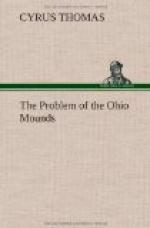It is a well-attested fact that northern as well as southern Indians were accustomed to erect palisades around their villages for defense against attack.
Some evidences of mound building by northern Indians may be found in the works of comparatively modern writers. Lewis C. Beck [Footnote: Gazetteer of the States of Ill. and Mo., p. 308.] affirms that “one of the largest mounds in this country has been thrown upon this stream [the Osage] within the last thirty or forty years by the Osages, near the great Osage village, in honor of one of their deceased chiefs.” It is probable this is the mound referred to by Major Sibley, [Footnote: Featherstoubaugh, Excur. through Slave States, p. 70.] who says an Osage Indian informed him that a chief of his tribe having died while all the men were off on a hunt, he was buried in the usual manner, with his weapons, etc., and a small mound was raised over him. When the hunters returned this mound was enlarged at intervals, every man carrying materials, and so the work went on for a long time, and the mound, when finished, was dressed off to a conical form at the top. The old Indian further said he had been informed, and believed, that all the mounds had a similar origin.
Lewis and Clarke mention not only the erection of a mound over a modern chief, but also numerous earthworks, including mounds, which were known to be the work of contemporaneous Indians. [Footnote: Travels, Dublin ed., 1817, pp. 30, 31, 55, 67, 115, 117, 122-125, etc.]
L. V. Bierce [Footnote: Historical Reminiscences of Summit County, Ohio, p. 128.] states that when Nicksaw, an old Wyandotte Indian of Summit County, was killed, “the Indians buried him on the ground where he fell, and according to their custom raised a mound over him to commemorate the place and circumstances of his death. His grave is yet to be seen.”
Another writer says: “It is related by intelligent Indian traders that a custom once prevailed among certain tribes, on the burial of a chief or brave of distinction, to consider his grave as entitled to the tribute of a portion of earth from each passer-by, which the traveler sedulously carried with him on his journey. Hence the first grave formed a nucleus around which, in the accumulation of the accustomed tributes thus paid, a mound was soon formed.” [Footnote: Smith’s History of Wisconsin, vol. 3, 1834, p. 245.]
The same author says [Footnote: Ibid., p. 262.] the tumulus at the Great Butte des Morts (Great Hill of the Dead) was raised over the bones of Outagami (Fox Indian) warriors slain in battle with the French in 1706.
According to a Winnebago tradition, mounds in certain localities in Wisconsin were built by that tribe, and others by the Sacs and Foxes.[Footnote: Wis. Hist. Soc., Rept. I, pp. 88, 89.]
There is another Indian tradition, apparently founded on fact, that the Essex mounds in Clinton County, Mich., are the burying places of those killed in a battle between the Chippewas and Pottawatomies, which occurred not many generations ago. [Footnote: Smithsonian Report, part 1, 1884, p. 848.]




